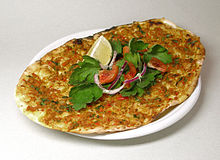Lahmacun
 Lahmajoun with salad | |
| Alternative names | Lahm b'ajeen, lahmacun |
|---|---|
| Type | Meat pie |
| Place of origin | Levant |
| Region or state | Western Asia |
| Main ingredients | minced meat, vegetables and herbs |
Lahmacun or Lahmajoun or Lahma bi-'ajin (Arabic: لحم بعجين; "meat with dough", Template:Lang-tr, Armenian: լահմաջու)[1], also known as Turkish pizza is a round, thin piece of dough topped with minced meat (most commonly beef or lamb) minced vegetables and herbs including onions, tomatoes and parsley, and spices such as cayenne pepper, paprika, cumin and cinnamon, then baked.[2][3] Lahmacun is often served with ayran or şalgam and wrapped around vegetables, including pickles, tomatoes, peppers, onions, lettuce, and roasted eggplant.[4][5][6][7] Over variants of lahmajoun are known as Armenian Pizzaor Lebanese pizza or Syrian pizza or Arab pizza
Other than Lahmacun, Sfiha, Manakish, and Musakhan are also other dishes with toppings on top of dough (Meat, Zaatar, Jibneh) that originated in the Levant. Lahmacun is a popular dish in Armenia,[8] Lebanon,[1] Syria,[1] Turkey,[8] and in Armenian and Turkish communities worldwide.[8] The dish has existed for thousands of years but has become much more popular over the last few decades.[8] The dish is sometimes known as "Armenian pizza".[9][10][11] Due to the hostile nature of the relations between Armenia and Turkey, the opening of Armenian restaurants serving the food in Russia had caused protests.[12] The dish was first eaten by Arabian sheikhs in the desert unable to carry fresh foods with them. [13]
Name
The name of the word Lahmajoun derives itself from the Arabic: لحم عجين, laḥm ʿajīn, short for Arabic: لحم بعجين, laḥm bi-ʿajīn, meaning meat with dough. Other forms of the name are the Template:Lang-tr and Armenian: լահմաջու lahmaǰu and լահմաջո lahmaǰo. [14]
See also
References
- ^ a b c Marks, Gil (1999). The World of Jewish Cooking. New York: Simon and Schuster. p. 37. ISBN 978-0-684-83559-4.
- ^ Jousiffe, Ann (1998). Lebanon. Lonely Planet. ISBN 9780864423504.
- ^ Pizzeria, Manoosh (2016-08-25). "Delicious Lahembajin: The Irresistible Lebanese Meat Pizza". Retrieved 2016-08-25.
- ^ Ghillie Basan (1997). Classic Turkish Cookery. Tauris Parke Books. p. 95. ISBN 1-86064-011-7.
- ^ Allen Webb (2012). Teaching the Literature of Today's Middle East. Routledge. pp. 70–. ISBN 978-1-136-83714-2.
- ^ Sally Butcher (2012). Veggiestan: A Vegetable Lover's Tour of the Middle East. Anova Books. pp. 128–. ISBN 978-1-909108-22-6.
- ^ Jeff Hertzberg, M.D.; Zoë François (2011). Artisan Pizza and Flatbread in Five Minutes a Day. St. Martin's Press. pp. 293–. ISBN 978-1-4299-9050-9.
- ^ a b c d Carol Helstosky (2008). Pizza: A Global History. London: Reaktion Books. pp. 59–. ISBN 978-1-86189-630-8.
- ^ "Armenian Pizza (aka Lahmajoon)". Foodnetwork.com. Retrieved 3 February 2015.
- ^ "At Armenian Market & Bakery, pizzas and more". The Boston Globe. 18 April 2012. Retrieved 3 February 2015.
{{cite web}}: Italic or bold markup not allowed in:|publisher=(help) - ^ "'Armenian Pizza' Is the Comfort Food You Didn't Know You Were Missing". Smithsonian. 29 December 2017.
- ^ McKernan, Bethan (27 October 2016). "A 'pizza war' has broken out between Turkey and Armenia". The Independent. Retrieved 10 December 2016.
- ^ Nathan, Joan (1984). An American Folklife Cookbook. Schocken Books. ISBN 9780805239140.
- ^ Nathan, Joan (1984). An American Folklife Cookbook. Schocken Books. pp. Page 258 ""Meat on Dough"" Arabian Sheikhs. ISBN 9780805239140.
